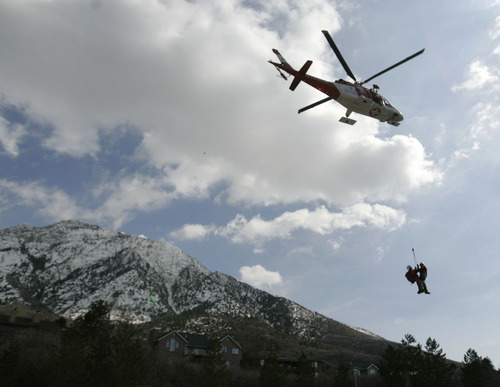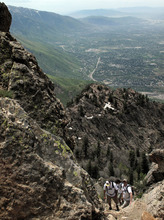This is an archived article that was published on sltrib.com in 2012, and information in the article may be outdated. It is provided only for personal research purposes and may not be reprinted.
Every year, a handful of hikers who make it to the summit of Mount Olympus find themselves lost and "cliffed out" while trying to retrace their steps down the 600 feet of steep, rocky, trail-less terrain that comprises the peak.
Unable to climb up or down, they are stuck on the face of the iconic mountain that looms over the Salt Lake Valley. And some are forced to spend the night, watching the lights of the city teasingly twinkling below them — so close, yet impossible to reach.
So far this year, search-and-rescue crews have conducted three rescues off the popular peak, according to Unified Police Lt. Justin Hoyal, including the June 30 rescue that resulted in the death of Utah Highway Patrol Trooper Aaron Beesley.
Beesley, 34, was on a helicopter rescue mission when he fell to his death on the mountainside. Authorities said the trooper had thrown a medical bag from the helicopter, and when the pilot returned to pick up Beesley after taking the two stranded teens to the base of the mountain, he found the trooper had slipped while reaching for his bag and had fallen some 60 feet to his death.
Hoyal said those two rescued hikers found themselves in the same situation that many others do every year.
"People get up there and don't see [the trail] or get off [on] the wrong trail," he said. "A lot has to do with that there are multiple trails, and [hikers] are not familiar with the area."
Hoyal said hikers in Salt Lake County most often need search-and-rescue services at Mount Olympus, Lake Blanche and the Storm Mountain climbing area.
Search-and-rescue crews were sent on 46 assists in 2011, according to the Search and Rescue Advisory Board. Five of those rescues were at Mount Olympus, Hoyal said, and another was at nearby Neffs Canyon. Hoyal said that hikers often take a wrong path at Mount Olympus and end up in Neffs or Heughs canyons, or vice versa.
Park City resident Mindi Tagge, 25, found herself in that situation on July 4, 2004.
Tagge said she was a senior in high school when she decided to hike Mount Olympus to watch fireworks with her boyfriend.
"We started heading down, and there's not really a specific trail," she said. "We just started going down, and we were watching the city lights, and ended up not being on the correct trail."
Tagge said it was very dark by the time they realized that they were in a spot where they couldn't head up or down. She said they stayed put and decided to wait until morning to figure out what to do next.
"I definitely was thinking, once the sun came out, it would help us a lot," Tagge said.
Tagge's parents had expected her to be home by midnight, but when 2 a.m. came and passed with no sign of their daughter, her father said they alerted police. By dawn, a rescue helicopter had spotted the two, and after several hours, rescuers helped the teenagers rappel down about 300 feet to get off the mountain.
Tagge said she had never hiked the Mount Olympus trail and hasn't hiked it since. She said she felt the trail was not well-marked, and had there been other signs or better markings, she may have never lost her way, and search- and-rescue crews wouldn't have been needed.
"It definitely would have solved the problem," she said.
Thayne Tagge, Mindi's father, said he and his wife looked into the situation and decided the teens weren't to blame.
"We realized that the trail was not marked properly enough," he said. "Enough people travel up there, and there's too many ways to lose the trail."
Thayne Tagge said he called the U.S. Forest Service offices after his daughter's 2004 rescue, requesting more signs in the area to help limit lost hikers.
"They just said, 'We're aware of the problem, but we're not doing anything about it at this time,' " he said.
The father said he feels that if the trail were better marked, it could lead to fewer lost hikers and save search-and-rescue resources.
Forest Service Recreation program manager Steve Scheid said service officials met with law enforcement about two years ago to discuss the prolific problem of hikers getting lost in the area. He said they put a directional sign where hikers were most often veering off the trail into Heughs Canyon, but the problem has persisted.
Scheid said the narrow trail up the 9,026-foot-tall mountain ends about 600 feet from the top of Mount Olympus. After the trail ends, hikers must scramble up the rocky face of the peak.
"You can't build a trail through that billy goat country," said Scheid, who acknowledged that hikers often lose their way coming down from the peak.
Scheid said the Forest Service tries to limit the number of signs on a hiking trail, especially in designated wilderness areas. And Mount Olympus is no different, though it is considered somewhat of an "urban wilderness" because of its proximity to Salt Lake City.
But the mountain's nearness to the city and easy accessibility — the trail head is right on Wasatch Boulevard at about 5400 South — can lure people into a sense of complacency.
"It's kind of the icon trail, everyone wants to go climb Mount Olympus," Scheid said. "People have a picture of Mount Olympus being a nice hike. But it's a steady, steep hike with no water, and people get themselves into trouble. You are leaving a maintained trail and summiting the peak."
Scheid said most hikers who get into trouble are not at the proper skill level or underestimate the mountain. He said the Forest Service doesn't send rangers to that area in the summer because the sun beating on the west-facing slope and tough elevation gain — about 4,000 feet in just 3.5 miles — make the trail especially difficult.
Hoyal said hikers should make sure they are prepared before attempting the hike. He advises bringing plenty of water and food — and a cellphone, so they can contact law enforcement if they need to be rescued.
jmiller@sltrib.com Twitter: @jm_miller





